A Tale of Two Weaves: Tapestry and Brocade Techniques in Dragons on the Tibetan Plateau
04 February 2021
In the virtual exhibition Dragons on the Tibetan Plateau: Selected Textiles from the Mactaggart Art Collection, two different weaving techniques with distinct processes and visual patterns can be seen: brocade and tapestry. Textiles with these techniques display auspicious symbols and represent a cross-cultural significance between Tibet and China. Although they are both considered weaving techniques, the tales behind brocade and tapestry weaving are very different.
Weaving Techniques in Dragons on the Tibetan Plateau
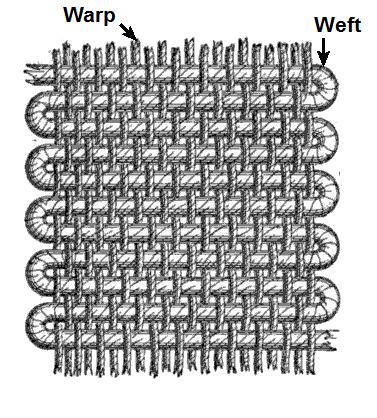
Weaving is a textile production technique that involves interlacing two sets of thread, the warp and weft, to form a fabric. This fabric is woven on a loom, a device that helps manipulate warp and weft threads to achieve different woven fabric structures and patterns that vary in complexity. Compared to embroidery techniques, which are applied to the surface of a finished textile, weaving techniques create patterns that are embedded within the fabric structure.
In China, the practice of silk-weaving has existed for more than 5,000 years and was developed alongside the process of silk cultivation. In the Dragons on the Tibetan Plateau exhibition, textiles that demonstrate brocade and tapestry weaving techniques represent the height of their popularity and technical expertise during the Ming and Qing Dynasties.
Ke-Si (Tapestry) Weaving
Tapestry weaving is also referred to as ke-si, meaning “cut silk” or “carved silk”. It is a technique that uses multiple, coloured weft threads to create intricate and colourful patterns. Using a tapestry loom, the weaver has plenty of freedom in determining the final pattern as they work.
Ke-si weaving techniques became widely used during the Song Dynasty (960-1279). When compared to European tapestries, ke-si used a higher density of coloured multi-toned silk threads to create bold patterns that looked more natural. Ke-si tapestry-woven fabrics can be identified by distinct slits in the fabric at the edges of colourful sections. The slits that are visible at the edges of colourful sections are a key distinguishing feature of this fabric and Chinese-style tapestry from other types of tapestry made in other countries.
By the Ming Dynasty, this style of weaving was so popular that ke-si fabrics were used for a variety of household applications, which included clothing, shoes, home furnishings, and wall art. Tapestry weaving was not limited by the size of its loom; large and wide lengths of fabric could be created at one time to make fully-patterned robes.
In the exhibition, the textile “Gold Silk Tapestry Weave Tibetan Chuba” (2005.5.253) demonstrates ke-si techniques. Patterns were woven into the fabric structure but they are densely packed with multiple colours and tones to create movement and a bright quality that stands out. Looking at the dragon head, there are visible slits between colourful sections.
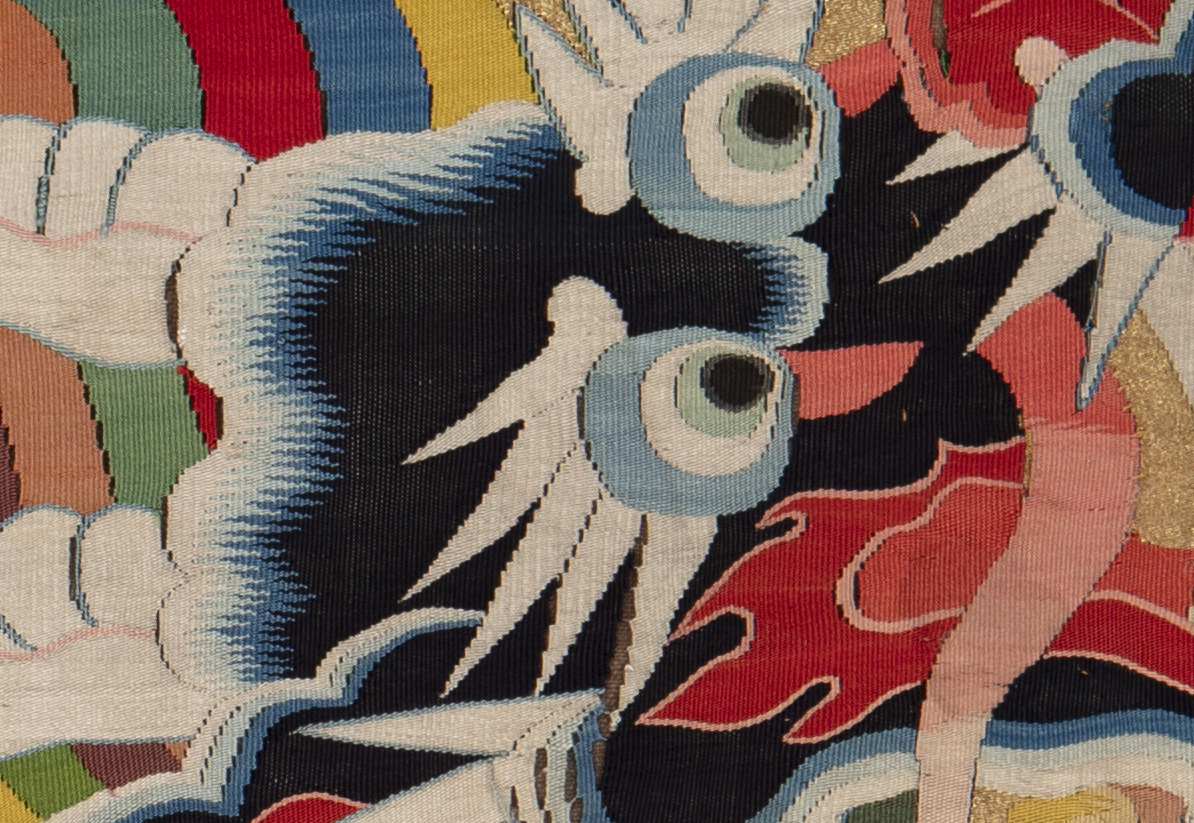
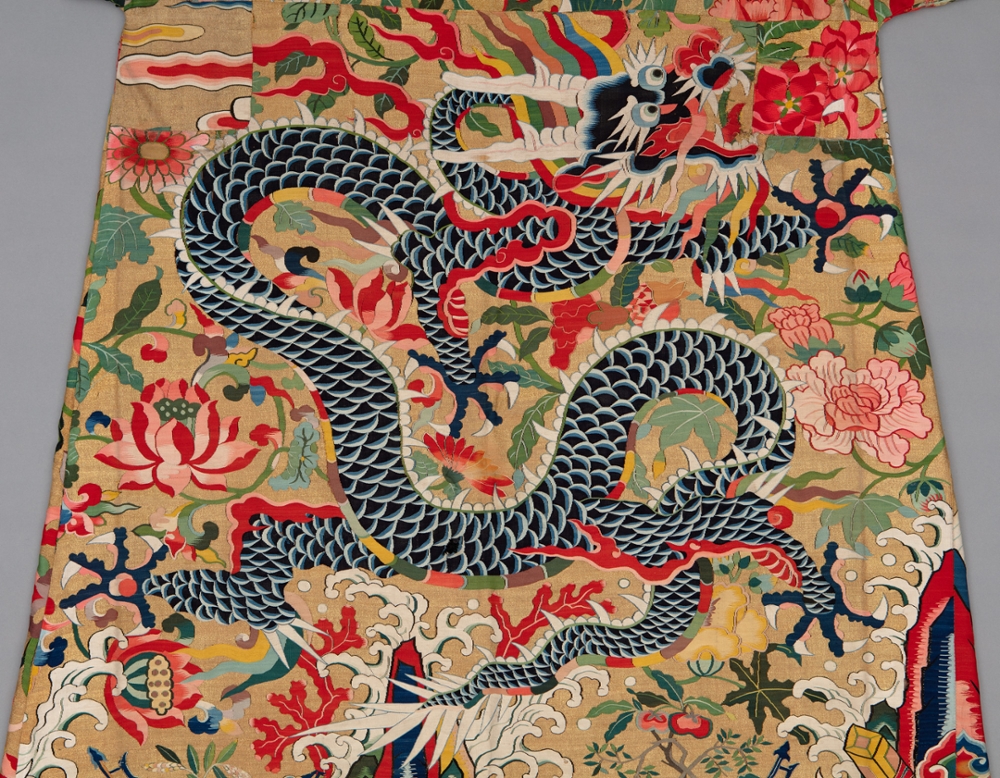
Isabel Pi-fen Chueh, curator of the exhibition and of the Mactaggart Art Collection, notes that the “Gold Tapestry Weave Tibetan Chuba” is one of her favourite textiles in the exhibition. “I love the design,” says Chueh, “it looks like a dragon leisurely walking and enjoying the flowers.”
Brocade Weaving
Like styles of embroidery, there are various types of brocade weaving. Nanjing Yunjin brocade is most prominent in this exhibition and it has become associated with luxurious fabric containing silk yarns, gold-wrapped threads, and peacock feathers spun into yarns.
Brocade weaving is created by inserting additional weft threads to create ornamental patterns in certain sections of the fabric. The additional weft yarns are added only in specific areas to create patterns rather than being continuously woven throughout the fabric. Brocade is woven on a complex drawloom operated by two weavers, with one person handling the top of the loom and the second person operating the lower section (pictured below). Due to the complexity of its loom setup, brocade fabric requires extensive pattern planning in advance.
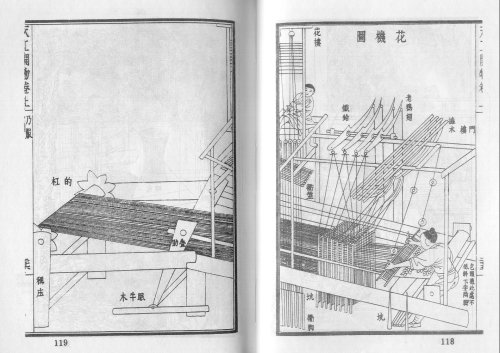
Looms were often not wide enough to weave the full width of a robe. To create patterned fabric for robes, brocade fabrics would be woven in halves and joined at the centre front of the robe. On the textiles “Brown Silk Brocade Tibetan Chuba” (2005.5.100) and “Blue Silk Tibetan Chuba,” (2005.5.107) we can see seams at the centre front of the garments where the brocade halves have been joined.
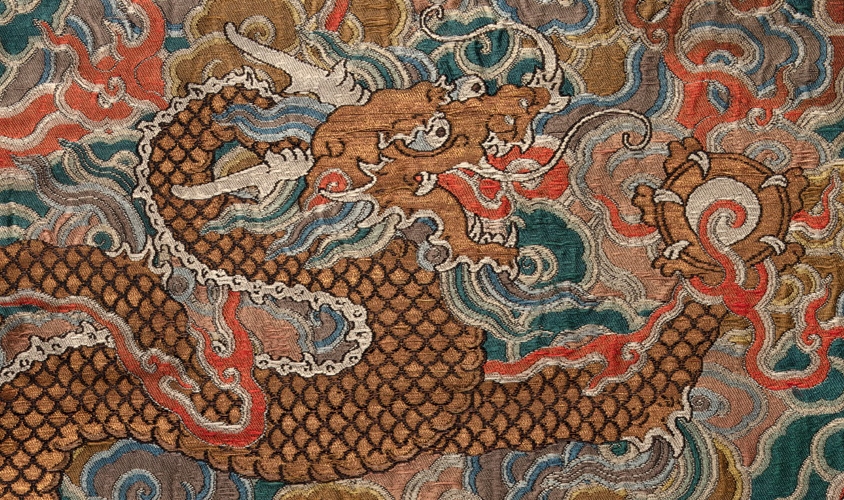
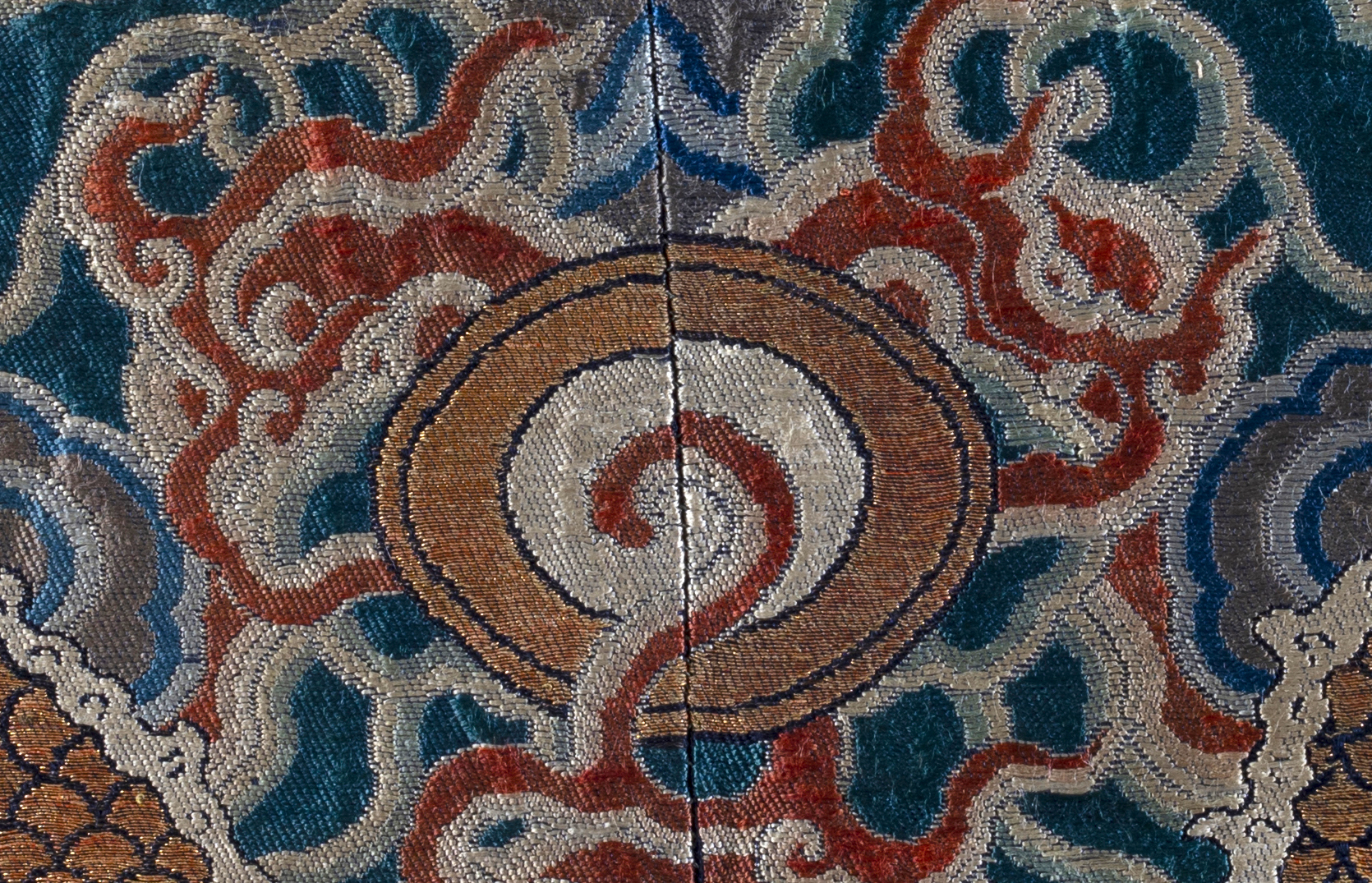
In the exhibition, the textiles “Brown Silk Brocade Tibetan Chuba” and “Blue Silk Brocade Tibetan Chuba” show variations of brocade techniques. Compared to ke-si tapestry, brocade can achieve extremely complex patterns. However, the colour palettes will be less bold as the weft threads are not as densely packed together in the fabric structure. “Blue Silk Brocade Tibetan Chuba” is an excellent example of how patterns are inlaid in brocade fabrics; the dragon-patterned roundels are added in certain sections of the fabric but are not continuously woven throughout the blue background.
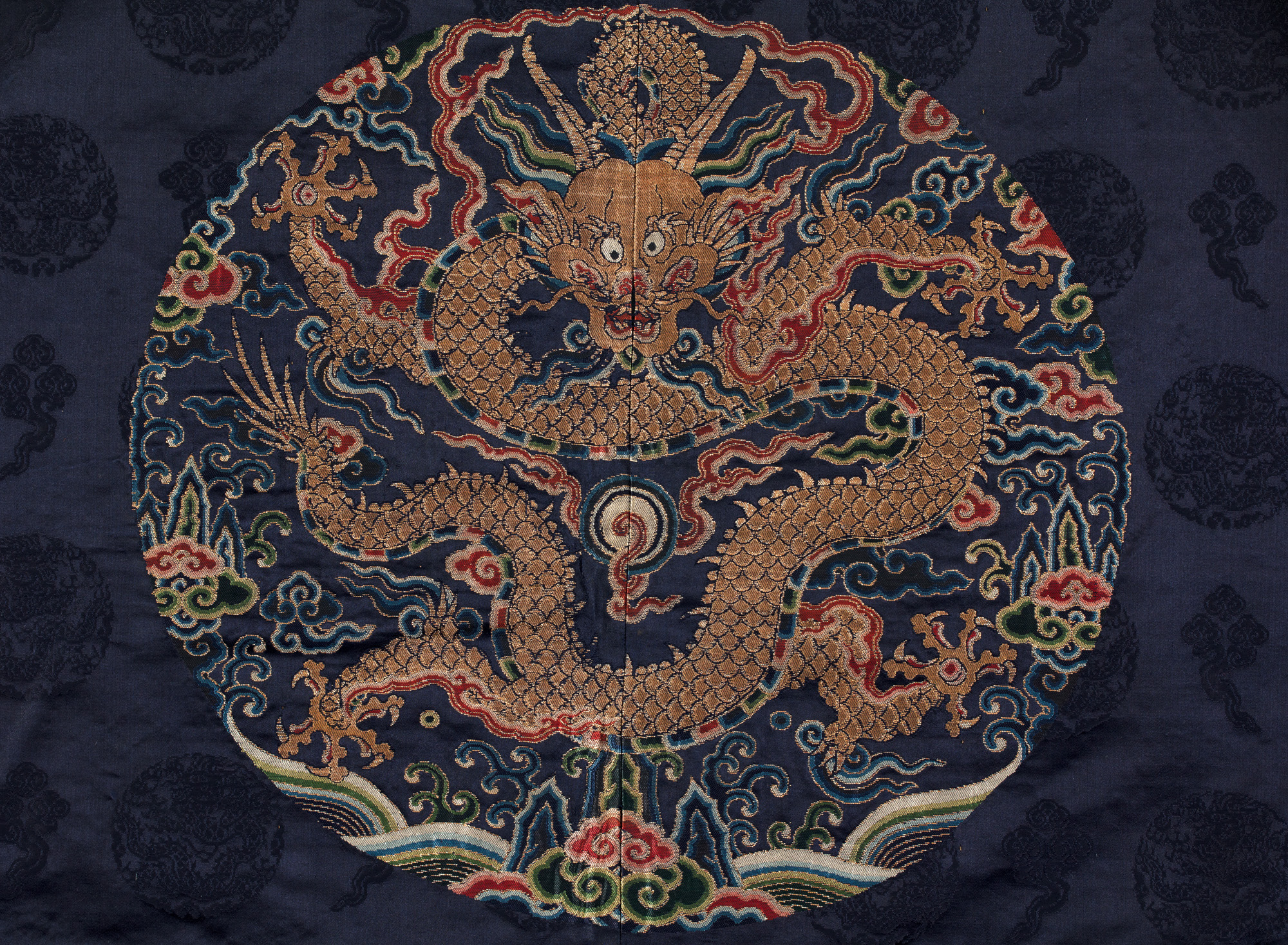
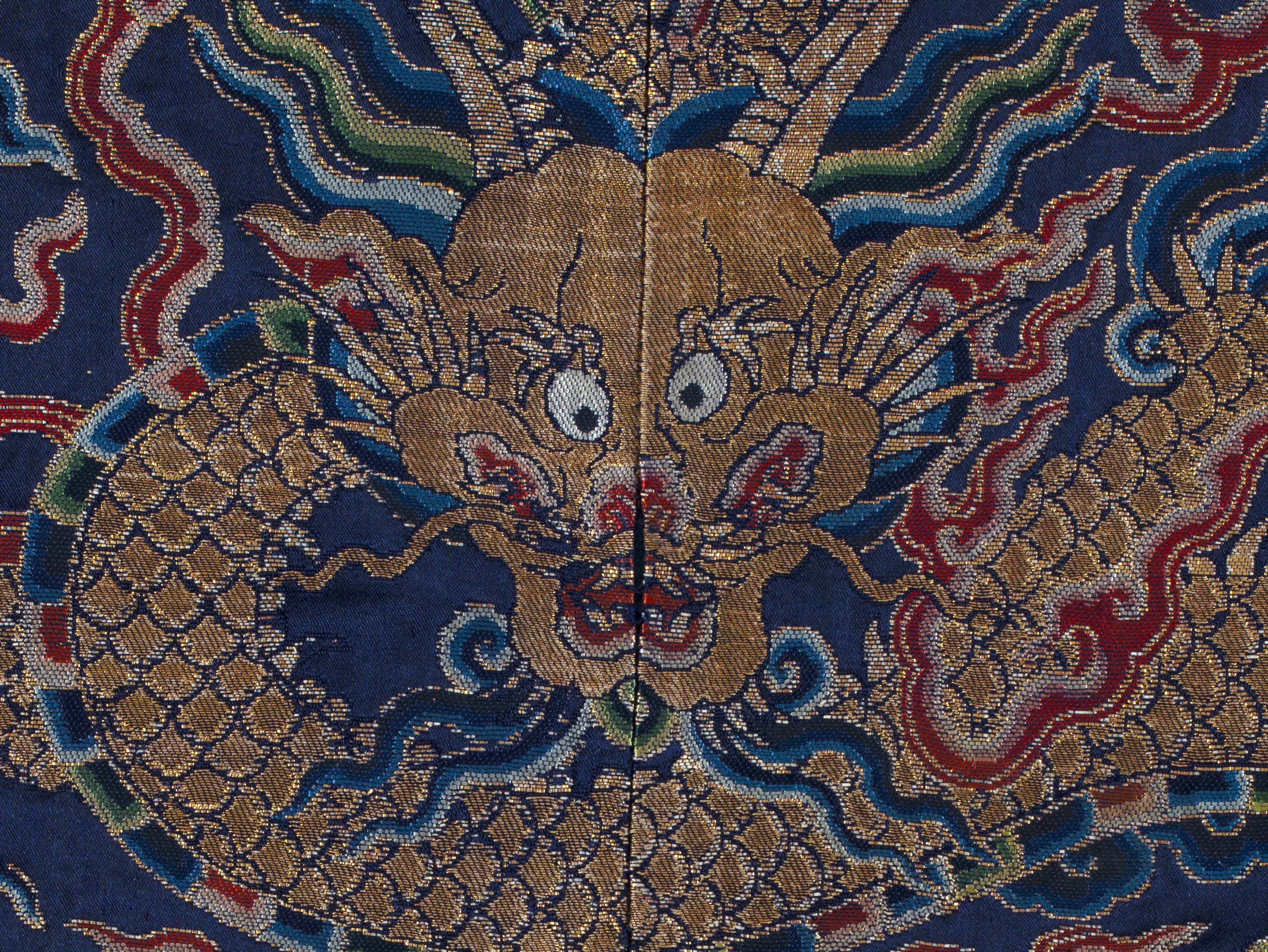
The time and labour required to make brocade or ke-si fabrics would have varied considerably depending on the design, pattern, and measurement. A single coloured, two-toned damask with dragon medallions or embroidered edges, like this robe, may have taken 32 workdays to complete. Whereas a robe made for an empress with all-over designs and five-claw dragon patterns could take 190 workdays to complete.
Explore more examples of brocade in the Mactaggart Art Collection, here and more examples of tapestry, here.
Weaving Today
The weaving techniques in Dragons on the Tibetan Plateau represent a high-point in Chinese textile production and craftsmanship. Both ke-si tapestry and Nanjing Yunjin brocade are still produced today using traditional methods; the Nanjing Yunjin brocade has been specifically recognized as UNESCO Intangible Cultural Heritage.
If comparing brocade and ke-si tapestry fabrics produced today to those produced during the Ming and Qing dynasties, there are some differences.
“There are few people who have the mastery level skill to weave these high-quality fabrics today,” says curator, Isabel Chueh, “even though traditional methods are still used, there is a difference in quality you notice if you compare today’s fabrics with those in the collection.”
While it takes many years to achieve the mastery of skill to weave the textiles seen in Dragons on the Tibetan Plateau, tapestry weaving is an excellent beginner’s introduction to weaving that you can try at home with a few basic materials. Try learning how to weave your own basic tapestry wall-hanging, here.
Image Credits
Warp and Weft:
By Alfred Barlow, Ryj, PKM - Adapted from The History and Principles of Weaving by Hand and by Power by, 1878, S. Low, Marston, Searle & Rivington, London is licensed under CC BY-SA 3.0
Ke-si Tapestry Weave:
Details from “Gold Silk Tapestry Weave Tibetan Chuba,” 1573-1700; metal-wrapped thread and silk tapestry weave; Mactaggart Art Collection; University of Alberta Museums; Gift of Sandy and Cécile Mactaggart; 2005.5.253
Brocade Weave:
Details from “Brown Silk Brocade Tibetan Chuba,” 1622-1735; brown silk and metal-wrapped thread brocade; Mactaggart Art Collection; University of Alberta Museums; Gift of Sandy and Cécile Mactaggart; 2005.5.100
Details from “Blue Silk Brocade Tibetan Chuba,” 1736-1750; dark blue silk satin damask with silk and metal-wrapped thread brocaded roundels; Mactaggart Art Collection; University of Alberta Museums; Gift of Sandy and Cécile Mactaggart; 2005.5.107
Drawloom:
Chinese drawloom for figure-weaving, from the Tiangong Kaiwu encyclopedia published in 1637, by Song Yingxing (1587-1666) is licensed under public domain.